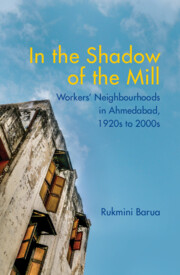Part II - Property and Precarity
Published online by Cambridge University Press: 15 June 2022
Summary
In speaking of housing arrangements and property claims of Ahmedabad's working poor, it would be interesting to take the Sabarmati riverfront relocation housing projects as a starting point. The on-going Sabarmati Riverfront Development Project, which appears to be one of Ahmedabad's ‘proudest’ achievements, was sanctioned in 1997. Work began along the riverfront around the mid-2000s, during the course of which tens of thousands were evicted from their residences on the banks of the river to relocation sites scattered across the city, one of which is Vatva.
From the late 1990s onwards, the urgency with which projects of urban renewal were planned and executed was linked to certain global trends, as cities worldwide were being remade to attract capital investments. The Sabarmati Riverfront Development Project, widely acknowledged as Narendra Modi's ‘pet project’, was one such, involving state acquisition of urban land, large-scale displacement of worker settlements and real estate development. The AMC established a special purpose vehicle, the Sabarmati Riverfront Development Corporation Limited (SRFDCL), in 1997 to execute the project. Within a year, a private planning outfit headed by architect and urban planner Bimal Patel, the Environment and Planning Collaborative (EPC), produced a proposal for the project, which also included plans for rehabilitation. As construction began, the initial plans for resettling displaced households within 2–3 kilometres of their original residences were largely abandoned, as ‘entrepreneurial politics’ increasingly governed the orientation of the project.
The riverfront slums were demolished between 2006 and 2011 and a fraction of those were resettled under the Basic Services for the Urban Poor scheme (BSUP) of the Jawarharlal Nehru National Urban Renewal Mission (JNNURM). The evictions began without a concrete plan for resettlement, which was then ordered by the Gujarat High Court in view of the PIL filed by the Sabarmati Nagrik Adhikar Manch and Girish Patel. The resettlement sites were spread across the city, a few in vacant mill lands in eastern Ahmedabad and the bulk concentrated in outlying industrial areas such as Vatva and Odhav. Resettlement would then effectively splinter employment and social ties, pushing most residents to the outskirts of the city.
The process of acquiring rights to resettlement was long and arduous, mediated by civil society organisations and local politicians. For many riverfront dwellers, the shift from slum housing along the Sabarmati to the high-rise resettlement quarters was a staggered one.
- Type
- Chapter
- Information
- In the Shadow of the MillWorkers' Neighbourhoods in Ahmedabad, 1920s to 2000s, pp. 173 - 177Publisher: Cambridge University PressPrint publication year: 2022

